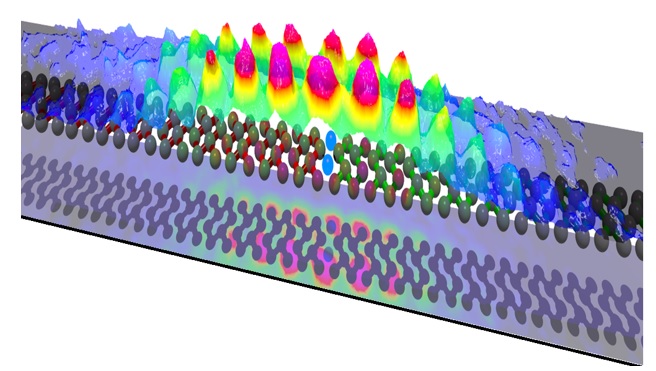Thursday, 8 October 2015
A team of Korean scientists, from the Center for Artificial Low Dimensional Electronic Systems (CALDES) within the Institute for Basic Science (IBS) led by Director Han Woong Yeom, has discovered a new class of solitons, which they named chiral solitons.
A soliton is a charged electron wave pocket found between two different topological states of one- dimensional (1-D) materials. It is self-reinforced, thus an extremely stable wave pocket or a pulse that maintains its shape while it propagates, like a tsunami wave or the way in which blood is pumped throughout our bodies. These are the hallmark of two (2-D) and three-dimensional (3-D) topological materials, however their one-dimensional analog has never before been found. In conducting polymers such as polyacetylene, topological solitons exist. Polyacetylene is a zigzag carbon chain, with each carbon atom bonded with a hydrogen atom. Along the carbon chain, single and double bonds between carbon atoms alternate, resulting in a large energy gap between occupied states and empty states. Experimentally polyacetylene was found to be conducting. Nobel laureate Alan J. Heeger explained this conducting nature using the domain wall - a topological defect between two different bond-alternation domains, which is called solitons.
Movement toward chirality
The CALDES team reported a new class of solitons existing on indium atomic wires. Indium atoms deposited on a silicon surface at an elevated temperature self-organize into an ordered array of metallic wires, stabilizing in furrows on silicon surfaces. They undergo a charge density wave (CDW) transition at 125 K. Below the CDW transition it is insulating and, importantly, has four distinct CDW domains, compared to two in polyacetylene. The team found that the four domains result in three different kinds of solitons, instead of one in polyacetylene. The additional two solitons have an interesting property, primarily they are charged with one electron or one hole even without doping impurities. They named these two solitons as the right-chiral and left-chiral solitons.
The team also reported that chiral solitons, topological edge states in 1-D atomic chains, are related with the chiral edge states of the 2-D topological system of quantum Hall insulators. The chiral edge states are responsible for the conducting channel present at the edges or surfaces of the noble 2-D and 3-D topological materials, which are insulating in bulk inside, but are metallic at their edges and surfaces.
The CALDES team has shown, using dimensional extension by adiabatic phase evolution, that the indium wire can be mapped to a 2-D quantum Hall insulator. This mapping not only indicates that the charge transport by chiral solitons are topologically protected, being robust to defects or perturbations that do not close the CDW gap, but also reveals how the concept of noble 2-D materials can be extended to 1-D.
The Korean research team, speaking from their lab in Pohang said, “the chiral solitons, charged topological defects in an insulating wire, can be utilized for future single-electron information storage devices that store and release electrons one by one.” They also remarked about the need to search other 1-D counterparts of known 2-D noble materials, which is expected to have unknown noble properties.
References
Sangmo Cheon, Tae-Hwan Kim, Sung-Hoon Lee, Han Woong Yeom(2015), Chiral Solitons in a Coupled Double Peierls Chain, SCIENCE













